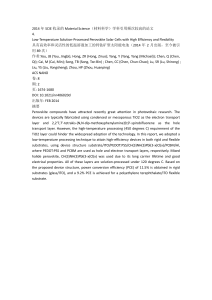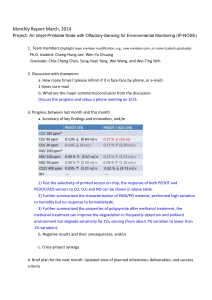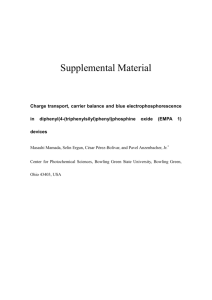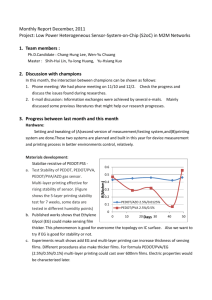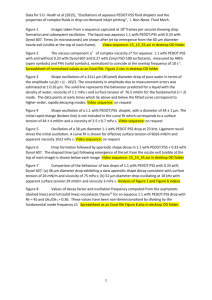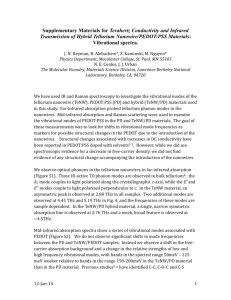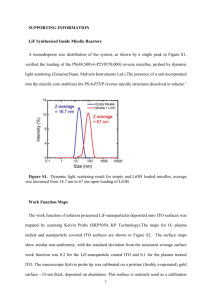Fabrication of PEDOT–OTS-patterned ITO substrates
advertisement
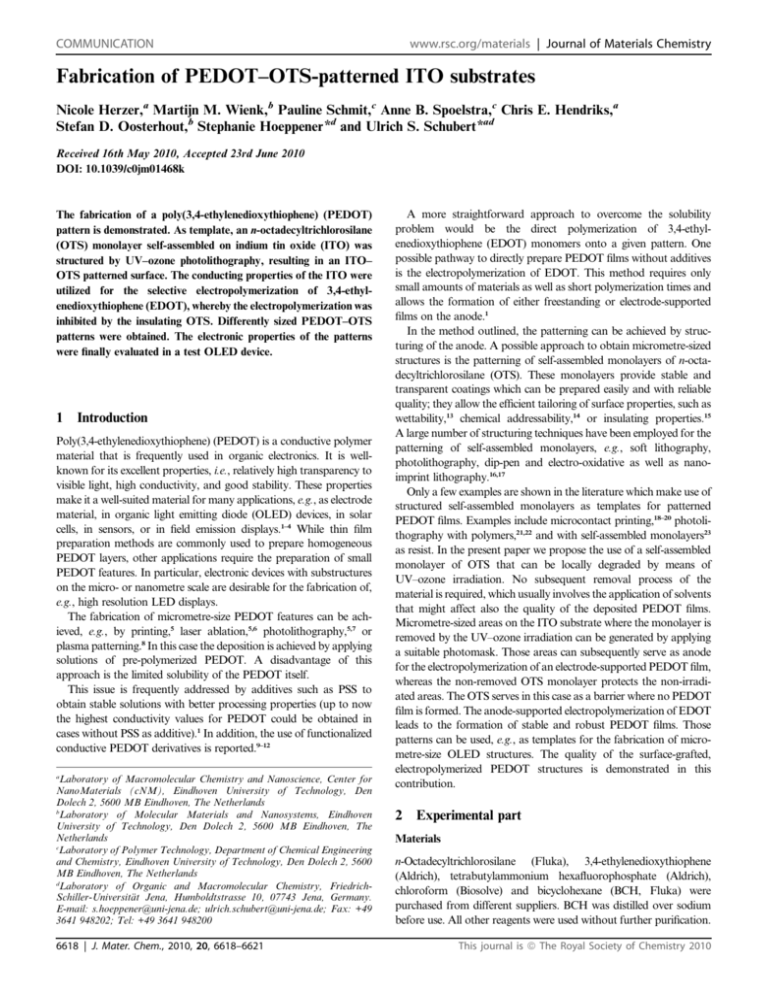
COMMUNICATION www.rsc.org/materials | Journal of Materials Chemistry Fabrication of PEDOT–OTS-patterned ITO substrates Nicole Herzer,a Martijn M. Wienk,b Pauline Schmit,c Anne B. Spoelstra,c Chris E. Hendriks,a Stefan D. Oosterhout,b Stephanie Hoeppener*d and Ulrich S. Schubert*ad Received 16th May 2010, Accepted 23rd June 2010 DOI: 10.1039/c0jm01468k The fabrication of a poly(3,4-ethylenedioxythiophene) (PEDOT) pattern is demonstrated. As template, an n-octadecyltrichlorosilane (OTS) monolayer self-assembled on indium tin oxide (ITO) was structured by UV–ozone photolithography, resulting in an ITO– OTS patterned surface. The conducting properties of the ITO were utilized for the selective electropolymerization of 3,4-ethylenedioxythiophene (EDOT), whereby the electropolymerization was inhibited by the insulating OTS. Differently sized PEDOT–OTS patterns were obtained. The electronic properties of the patterns were finally evaluated in a test OLED device. 1 Introduction Poly(3,4-ethylenedioxythiophene) (PEDOT) is a conductive polymer material that is frequently used in organic electronics. It is wellknown for its excellent properties, i.e., relatively high transparency to visible light, high conductivity, and good stability. These properties make it a well-suited material for many applications, e.g., as electrode material, in organic light emitting diode (OLED) devices, in solar cells, in sensors, or in field emission displays.1–4 While thin film preparation methods are commonly used to prepare homogeneous PEDOT layers, other applications require the preparation of small PEDOT features. In particular, electronic devices with substructures on the micro- or nanometre scale are desirable for the fabrication of, e.g., high resolution LED displays. The fabrication of micrometre-size PEDOT features can be achieved, e.g., by printing,5 laser ablation,5,6 photolithography,5,7 or plasma patterning.8 In this case the deposition is achieved by applying solutions of pre-polymerized PEDOT. A disadvantage of this approach is the limited solubility of the PEDOT itself. This issue is frequently addressed by additives such as PSS to obtain stable solutions with better processing properties (up to now the highest conductivity values for PEDOT could be obtained in cases without PSS as additive).1 In addition, the use of functionalized conductive PEDOT derivatives is reported.9–12 a Laboratory of Macromolecular Chemistry and Nanoscience, Center for NanoMaterials (cNM), Eindhoven University of Technology, Den Dolech 2, 5600 MB Eindhoven, The Netherlands b Laboratory of Molecular Materials and Nanosystems, Eindhoven University of Technology, Den Dolech 2, 5600 MB Eindhoven, The Netherlands c Laboratory of Polymer Technology, Department of Chemical Engineering and Chemistry, Eindhoven University of Technology, Den Dolech 2, 5600 MB Eindhoven, The Netherlands d Laboratory of Organic and Macromolecular Chemistry, FriedrichSchiller-Universit€ at Jena, Humboldtstrasse 10, 07743 Jena, Germany. E-mail: s.hoeppener@uni-jena.de; ulrich.schubert@uni-jena.de; Fax: +49 3641 948202; Tel: +49 3641 948200 6618 | J. Mater. Chem., 2010, 20, 6618–6621 A more straightforward approach to overcome the solubility problem would be the direct polymerization of 3,4-ethylenedioxythiophene (EDOT) monomers onto a given pattern. One possible pathway to directly prepare PEDOT films without additives is the electropolymerization of EDOT. This method requires only small amounts of materials as well as short polymerization times and allows the formation of either freestanding or electrode-supported films on the anode.1 In the method outlined, the patterning can be achieved by structuring of the anode. A possible approach to obtain micrometre-sized structures is the patterning of self-assembled monolayers of n-octadecyltrichlorosilane (OTS). These monolayers provide stable and transparent coatings which can be prepared easily and with reliable quality; they allow the efficient tailoring of surface properties, such as wettability,13 chemical addressability,14 or insulating properties.15 A large number of structuring techniques have been employed for the patterning of self-assembled monolayers, e.g., soft lithography, photolithography, dip-pen and electro-oxidative as well as nanoimprint lithography.16,17 Only a few examples are shown in the literature which make use of structured self-assembled monolayers as templates for patterned PEDOT films. Examples include microcontact printing,18–20 photolithography with polymers,21,22 and with self-assembled monolayers23 as resist. In the present paper we propose the use of a self-assembled monolayer of OTS that can be locally degraded by means of UV–ozone irradiation. No subsequent removal process of the material is required, which usually involves the application of solvents that might affect also the quality of the deposited PEDOT films. Micrometre-sized areas on the ITO substrate where the monolayer is removed by the UV–ozone irradiation can be generated by applying a suitable photomask. Those areas can subsequently serve as anode for the electropolymerization of an electrode-supported PEDOT film, whereas the non-removed OTS monolayer protects the non-irradiated areas. The OTS serves in this case as a barrier where no PEDOT film is formed. The anode-supported electropolymerization of EDOT leads to the formation of stable and robust PEDOT films. Those patterns can be used, e.g., as templates for the fabrication of micrometre-size OLED structures. The quality of the surface-grafted, electropolymerized PEDOT structures is demonstrated in this contribution. 2 Experimental part Materials n-Octadecyltrichlorosilane (Fluka), 3,4-ethylenedioxythiophene (Aldrich), tetrabutylammonium hexafluorophosphate (Aldrich), chloroform (Biosolve) and bicyclohexane (BCH, Fluka) were purchased from different suppliers. BCH was distilled over sodium before use. All other reagents were used without further purification. This journal is ª The Royal Society of Chemistry 2010 ITO glass slides were obtained from PGO and Naranjo Substrates. The ITO glass slides were treated on both sides for 30 minutes in a UV–ozone chamber before use. Preparation of patterned substrates OTS monolayers were prepared by immersing the ITO glass slides in a solution of OTS (5 mL) in BCH (5 mL) for 20 minutes, followed by sonication in chloroform. Finally, the slides were dried in a stream of air. This procedure was repeated twice. The patterning was performed by placing a TEM grid onto the OTS-modified ITO glass slides which were then incubated for two hours in a UV–ozone photoreactor. The TEM grids were fixed to the substrate by placing a UV transparent quartz slide on top of them. Electropolymerization of EDOT A droplet of a mixture of 3,4-ethylenedioxythiophene and tetrabutylammonium hexafluorophosphate was placed on the patterned substrate and a voltage of 2 V was applied for 30 minutes. The treated ITO glass slide was subsequently sonicated in chloroform. Preparation of OLED devices OLED devices were prepared onto OTS–PEDOT-patterned ITO substrates (Naranjo Substrates) in a glovebox. The photoactive layer tris(8-hydroxyquinolinato)aluminium (Alq3) as well as the counter electrode of LiF (1 nm) and aluminium (100 nm) were deposited by vacuum evaporation at 109 bar. Instruments A UV–ozone photoreactor (UPV, PR-100, Upland, CA) was used to perform the cleaning and patterning process. AFM measurements were recorded with a Solver LS system (NT-MDT). Tapping mode tips were obtained from mMash (NSC35). Optical images were recorded with a Solver LS system (NT-MDT) equipped with a CCD camera and a Hyperion 2000 FT-IR microscope from Bruker. The optical pictures of the OLED were taken by an Axioplan Imaging 2 from Zeiss in reflection, whereby the microscope light was turned off. XPS measurements were conducted on a VG Escalab MKII spectrometer equipped with a dual Al/Mg Ka X-ray source and a hemispherical analyzer with a five channeltron detector. Spectra were obtained using a magnesium anode (Mg Ka ¼ 1253.6 eV) operating at 480 W and a constant pass energy of 20 eV with a background pressure of 2 1012 bar. Spectra were referenced to the In (3d) peak at 451.1 eV of the ITO layer on the substrate.27 3 Results and discussions The schematic overview of the complete preparation process of the PEDOT–OTS patterns is depicted in Scheme 1. Smooth ITO substrates prepared on float glass with a typical roughness of <2 nm were utilized. On these substrates, OTS was selfassembled and the layers were inspected by contact angle goniometry, revealing a water contact angle of >110 . This indicates the formation of an OTS monolayer on the ITO substrate. The OTS monolayer was used as a chemically inert and fairly robust passivation layer. OTS was chosen due to the high stability, This journal is ª The Royal Society of Chemistry 2010 Scheme 1 Schematic overview of the preparation of a PEDOT–OTS pattern. (a) UV–ozone photopatterning of the OTS monolayer and (b) electropolymerization of EDOT. the ordered and close packing as well as the insulating properties of the molecules.24–26 The preparation of the patterned substrate was performed by locally applying UV–ozone irradiation on OTS through a mask structure. As a suitable photomask, TEM grids were used that could be fixed to the ITO substrate by placing a UV-transparent quartz slide on top of the TEM grid. This process allowed close contact of the entire TEM grid mask to the ITO substrate. TEM grids with different bar structures could be used to obtain different structure dimensions (100 mm hole size, 20 mm bar size for 200 mesh Ni grids and 30 mm hole size, 7 mm bar size for 600 mesh Cu grids, respectively). In the UV–ozone photoreactor, ozone was produced by the UV light; the ozone reacted with the alkyl chains of the OTS monolayer to form carbon oxide species. In the course of the irradiation the degradation of the monolayer took place. The removal of the OTS monolayer and the preparation of micrometre structures in the UV–ozone photoreactor were previously reported and investigated in detail.13 When, after the irradiation process, the photomask was removed, the surface of the slides showed a strong hydrophilic–hydrophobic contrast which resembled the structure of the used TEM grid photomasks: the bar structures remained hydrophobic, whereas the open spaces were hydrophilic and represented the characteristic hexagonal structure of the holes of the TEM grid. The patterns were then utilized for the electropolymerization of EDOT. As a reference, a non-structured PEDOT film was electropolymerized onto ITO substrates. A solution of EDOT and tetrabutylammonium hexafluorophosphate (which is known to support the formation of highly conductive PEDOT at room temperature1) was placed on top of the ITO surface. A platinum electrode was placed in the solution and the ITO substrate was used as anode. A voltage of 2 V was applied for 30 minutes to form an anode-supported PEDOT film. The substrate was subsequently cleaned by sonication in chloroform. The obtained films were characterized by XPS measurements (Fig. 1). The XPS spectrum shows indium and tin signals from the ITO coating and the expected sulfur as well as carbon signals from the PEDOT film. After successful formation of the PEDOT films on the nonstructured ITO substrates, the electropolymerization of EDOT on the structured ITO substrate was performed. In this case the patterned ITO substrates were used as anode in the electropolymerization setup and the polymerizations were performed utilizing the same conditions that were tested on non-structured ITO electrodes. The electropolymerization started from the conductive ITO layer and resulted in the formation of a 60 nm thick PEDOT film with a peak-to-peak roughness of approximately 10 nm. AFM investigations of the patterned PEDOT films demonstrated the selective growth of J. Mater. Chem., 2010, 20, 6618–6621 | 6619 Fig. 1 XPS measurement on an electropolymerized PEDOT film on ITO. a homogeneous PEDOT layer within the irradiated hexagonal structures (Fig. 2a–d). Due to the light blue color of the PEDOT films, the patterns were also visible under the optical microscope and again showed the selectivity of the electropolymerization in the hexagons (Fig. 2e). According to Fig. 2a, the AFM images show sharp borders, which indicate a good selectivity of the PEDOT polymerization as well as the good protection properties of the OTS-coated regions. The roughness of the films, depicted as representative line profiles (Fig. 2b and d), was not ideal and can certainly be further improved by optimization of the polymerization conditions. The stability of the OTS barrier structures between the individual anode structures was rather good, as no degradation or loss of the hydrophobic properties was observed during the electropolymerization process. By variation of the photomask, differently sized patterns could be obtained. In the present study TEM grids with hexagonal features provided anode structure sizes of 30 mm and 100 mm, respectively. In the case of 600 mesh TEM grid patterns the individual anode areas were separated by only 5 mm OTS features. In the case of 200 mesh Ni TEM grids, the corresponding anode structures were separated by 15 mm OTS regions. The differences in bar size between the actual TEM grids and the produced OTS patterns are supposedly the result of diffusion, at the edges of the TEM grids, of the active oxygen species during the patterning process. Patterned PEDOT–OTS structures as described above are interesting in terms of microfabrication. We have therefore tested whether the quality of the electropolymerized films and their electronic properties were sufficient to fabricate patterned OLED based on these structures. The schematic setup is depicted in Scheme 2. In this proof-of-concept study, a rather simple OLED device layout was chosen. Further improvement of the device performance can be expected by tuning the layer structure as well as the layer materials used to fabricate the OLED. Despite of its preliminary character, the device setup described was suitable to serve as a first test for the electronic performance of the patterned electropolymerized PEDOT–OTS films. For the device a different ITO substrate was utilized to fit into the evaporation system. The peak-to-peak roughness of these ITO substrates was approximately 5 nm. A 60 nm thick layer of Alq3 was evaporated Scheme 2 Schematic representation of the device setup. Fig. 2 AFM investigations and optical images of the PEDOT–OTS patterns: (a) AFM height image of the 30 mm PEDOT–OTS pattern, (b) representative height profile, (c) AFM height image of the 100 mm PEDOT–OTS pattern, (d) representative height profile, and (e) optical image of the 100 mm PEDOT–OTS pattern. Dark areas represent the areas where PEDOT films were grown on the ITO anode. 6620 | J. Mater. Chem., 2010, 20, 6618–6621 This journal is ª The Royal Society of Chemistry 2010 Acknowledgements N.H., S.H. and U.S.S. gratefully acknowledge the financial support of the Dutch Science Council (NWO) (VICI grant awarded to U.S.S.) and Prof. Dieter Schubert for his helpful comments. References Fig. 3 Optical photograph of the OLED based on the 100 mm PEDOT– OTS pattern. onto the PEDOT–OTS patterns, which served as light emitting layer, followed by a thin layer of LiF and finally a layer of 100 nm Al used as cathode of the OLED. Contacting this device and applying a bias voltage of 5 V led to the emission of green light from the device. For the optical image presented in Fig. 3, the bias voltage was increased to 7 V to allow observation of the light emission under a microscope. The image shows the light emitting from the hexagons where the PEDOT is located. The hexagonal structure of the patterned PEDOT films was clearly visible and the bars were not light emissive, which underlines the good insulating properties of the OTS monolayer. Light emission within the hexagons of Fig. 3 was not homogenous, which may be due to the rather rough structure of the grafted PEDOT film. It should be considered that, in principle, light could be also emitted from ITO areas which are not coated by PEDOT; the required voltage is, however, higher than applied here. The darker regions in the hexagons may thus even indicate the presence of discontinuities in the PEDOT film, which are not emissive because the drive voltage applied was not high enough to turn on the light without the PEDOT layer.28,29 In any case, further improvement of the structures and optimization of the electropolymerization process will be required. 4 Summary We have demonstrated the functionalization of ITO-coated substrates with self-assembled monolayers and their subsequent patterning by photolithography. The structured surfaces were applied as templates for the selective electropolymerization of EDOT in micrometre structures, leading to patterned PEDOT–OTS substrates. Films of a constant height of 60 nm and in different sizes were prepared. The microstructures were tested regarding their application in OLED and showed promising first results. Patterned PEDOT devices could be of interest for the development of micro-electronic construction elements such as transistors, displays or microfluidics. The combination of photolithography on selfassembled monolayers and electropolymerization used here provides an easy and fast route towards obtaining PEDOT microstructures. This journal is ª The Royal Society of Chemistry 2010 1 L. B. Groenendaal, F. Jonas, D. Freitag, H. Pielartzik and J. R. Reynolds, Adv. Mater., 2000, 12, 481. 2 J. Jang, Adv. Polym. Sci., 2006, 199, 189. 3 N. R. Armstrong, W. Wang, D. M. Alloway, D. Placencia, E. Ratcliff and M. Brumbach, Macromol. Rapid Commun., 2009, 30, 717. 4 S. Kirchmeyer and K. Reuter, J. Mater. Chem., 2005, 15, 2077. 5 E. Menard, M. A. Meitl, Y. Sun, J.-U. Park, D. J.-L. Shir, Y.-S. Nam, S. Jeon and J. A. Rogers, Chem. Rev., 2007, 107, 1117. 6 A. F. Lasagni, J. L. Hendricks, C. M. Shaw, D. Yuan, D. C. Martin and S. Das, Appl. Surf. Sci., 2009, 255, 9186. 7 P. G. Taylor, J.-K. Lee, A. A. Zakhidov, M. Chatzichristidi, H. H. Fong, J. A. DeFranco, G. G. Malliaras and C. K. Ober, Adv. Mater., 2009, 21, 2314. 8 A. Colsmann, F. Stenzel, G. Balthasar, H. Do and U. Lemmer, Thin Solid Films, 2009, 517, 1750. 9 S. Maaref and S. Sun, Polym. Mater. Sci. Eng., 2003, 88, 510. 10 R. D. McCullough, Adv. Mater., 1998, 10, 93. 11 I. Osaka, G. Sauve, R. Zhang, T. Kowalewski and R. D. McCullough, Adv. Mater., 2007, 19, 4160. 12 Z. Bao and A. J. Lovinger, Chem. Mater., 1999, 11, 2607. 13 N. Herzer, R. Eckardt, S. Hoeppener and U. S. Schubert, Adv. Funct. Mater., 2009, 19, 2777. 14 J. P. Renault, A. Bernard, D. Juncker, B. Michel, H. R. Bosshard and E. Delamarche, Angew. Chem., Int. Ed., 2002, 41, 2320. 15 D. Vuillaume, C. Boulas, J. Collet, J. V. Davidovits and F. Rondelez, Appl. Phys. Lett., 1996, 69, 1646. 16 D. Wouters, S. Hoeppener and U. S. Schubert, Angew. Chem., Int. Ed., 2009, 48, 1732. 17 S. Onclin, B. J. Ravoo and D. N. Reinhoudt, Angew. Chem., Int. Ed., 2005, 44, 6282. 18 J. J. Brondijk, X. Li, H. B. Ackerman, P. W. M. Blom and B. de Boer, Appl. Phys. A: Solid Surf., 2009, 95, 1. 19 S. Kim, I. Pang and J. Lee, Macromol. Rapid Commun., 2007, 28, 1574. 20 Y. Koide, M. W. Such, R. Basu, G. Evmenenko, J. Cui, P. Dutta, M. C. Hersam and T. Marks, Langmuir, 2003, 19, 86. 21 M.-H. Jung and H. Lee, Langmuir, 2008, 24, 9825. 22 H. S. Hwang, A. A. Zakhidov, J. K. Lee, X. Andre, J. A. DeFranco, H. H. Fong, A. B. Homes, G. G. Malliaras and C. K. Ober, J. Mater. Chem., 2008, 18, 3087. 23 E. Avnon, Y. Paz and N. Tessler, Appl. Phys. Lett., 2009, 94, 13502. 24 J. Sagiv, J. Am. Chem. Soc., 1980, 102, 92. 25 R. Maoz and J. Sagiv, J. Colloid Interface Sci., 1984, 100, 465. 26 M. Rittner, M. S. Martin-Gonzalez, A. Flores, H. Schweizer, F. Effenberger and M. H. Pilkuhn, J. Appl. Phys., 2005, 98, 54312. 27 T. P. Nguyen, P. Le Rendu, P. D. Long and S. A. De Vos, Surf. Coat. Technol., 2004, 180–181, 646. 28 P. J. Brewer, J. Huang, P. A. Lane, A. J. deMEllo, D. D. C. Bradley and J. C. deMello, Phys. Rev. B: Condens. Matter Mater. Phys., 2006, 74, 115202. 29 T. G. Andersson, M. Andreasson, U. Klement, C. B. Lee, B. Pujilaksono and A. Uddin, Mater. Sci. Eng., B, 2007, 145, 48. J. Mater. Chem., 2010, 20, 6618–6621 | 6621

